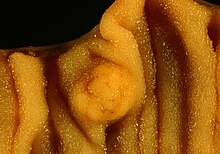
Back سرطان الأمعاء Arabic Nazik bağırsaq xərçəngi Azerbaijani Dünndarmkrebs German Cáncer de intestino delgado Spanish سرطان روده کوچک Persian Tumeurs de l'intestin grêle French סרטן המעי הדק HE Tumori tankog crijeva Croatian Tumore dell'intestino tenue Italian 소장암 Korean
| Small intestine cancer | |
|---|---|
| Other names | Small bowel cancer, cancer of the small bowel |
 | |
| Picture of a carcinoid tumour that encroaches into lumen of the small bowel. Pathology specimen. The prominent folds are plicae circulares, a characteristic of small bowel. | |
| Specialty | Gastroenterology, general surgery, oncology |
| Symptoms | vomiting blood, blood in the stool |
Small intestine cancer starts when cells in the small intestine start to grow out of control. The small intestine is the largest part of the gastrointestinal tract (GI tract), which processes food for energy and rids the body of solid waste. The small intestine is not as common as other cancers of the GI tract such as colon, rectal, stomach, and esophageal cancers in the United States. They account for fewer than 1 in 10 cancers in the GI tract, and fewer than 1 in 100 cancers overall. (American Cancer Society, 2023)
Small intestine cancer can be subdivided into duodenal cancer (the first part of the small intestine) and cancer of the jejunum and ileum (the latter two parts of the small intestine). Duodenal cancer has more in common with stomach cancer, while cancer of the jejunum and ileum have more in common with colorectal cancer. Five-year survival rates are 65%.[1]
Experts believe that small intestine cancer develops much like colorectal cancer. It first begins as a small growth on the inner lining of the intestine (polyp), which over time becomes cancer. (American Cancer Society, 2023)
Approximately 50% of adenomas of the small intestine arise in the duodenum even though this location comprises only 4% of the length of the small intestine. These adenomas occur mainly close to the ampulla of Vater, the outlet of the common bile duct from which bile acids are released.[2] This area is also closely associated with the pancreas, so they are treated as pancreatic cancer.
The small intestine works by mixing food and gastric juices into a thick fluid in the stomach and then emptied into the small intestine. It then continues to break down and absorb the nutrients. Although it is referred to as the small intestine, it is the longest section of the GI tract being approximately 20 feet long. The length of the small intestine comprises 75% of the length of the entire gastrointestinal tract[3]
There are three parts of the small intestine. The duodenum is the 1st section of small intestine and only about a foot long. The jejunum and ileum make up most of the small intestine. Most of the nutrients in food are absorbed into the bloodstream in these two parts. (American Cancer Society, 2023)
- ^ "SEER Stat Fact Sheets: Small Intestine Cancer". NCI. Retrieved 18 June 2014.
- ^ Ross RK, Hartnett NM, Bernstein L, Henderson BE. Epidemiology of adenocarcinomas of the small intestine: is bile a small bowel carcinogen. Br J Cancer 1991;63:143–5
- ^ Maguire A, Sheahan K. Primary small bowel adenomas and adenocarcinomas-recent advances. Virchows Arch 2018;473:265–73
© MMXXIII Rich X Search. We shall prevail. All rights reserved. Rich X Search